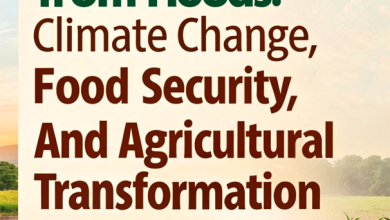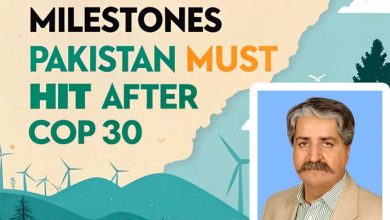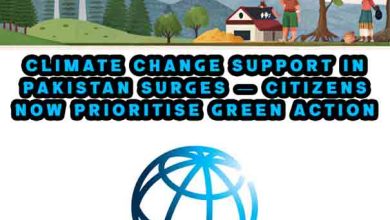Glacial Lake Outburst Floods Threaten Pakistan’s North | Urgent NDMA Alert
Pakistan warns of glacial lake outburst floods in northern regions due to rising temperatures. NDMA issues alert urging extreme caution. Learn more about GLOF risks and climate change impacts in Pakist
Glacial Lake Outburst Floods (GLOFs) have re-emerged as a grave threat to northern Pakistan as temperatures spike in June 2025. The National Disaster Management Authority (NDMA) has issued an urgent warning for potential flooding triggered by melting glaciers, affecting key mountainous regions like Gilgit-Baltistan and Chitral.
With over 7,000 glaciers, Pakistan has one of the largest concentrations outside the polar regions, making it highly vulnerable to climate-related disasters. These warnings are not merely speculative—they reflect the terrifying reality of accelerating glacial melt driven by climate change.
NDMA’s Urgent Alert Amid Soaring Temperatures
On June 26, NDMA issued a fresh advisory warning local communities, tourists, and trekkers about the increased risk of Glacial Lake Outburst Floods. According to the alert:
- Glacial melting is accelerating due to a combination of rising heat and a western weather system.
- There’s a high likelihood of sudden floods in vulnerable valleys.
- Infrastructure like bridges, roads, and power lines may face significant damage.
- People are urged to avoid riverbanks, glacial zones, and strictly follow evacuation orders.
The NDMA has partnered with provincial governments to enhance emergency response readiness, but the scale of risk demands broader awareness and community participation.
📖 Read also: Pakistan’s Climate Change Profile – Ministry of Climate Change
What Are Glacial Lake Outburst Floods (GLOFs)?
Glacial Lake Outburst Floods occur when water dammed by a glacier or a moraine is suddenly released. These outbursts are often:
- Rapid and violent, sweeping away everything in their path.
- Triggered by melting glaciers, landslides, or seismic activity.
- Capable of flooding entire villages, destroying critical infrastructure, and causing mass casualties.
The United Nations Development Programme (UNDP) has highlighted GLOFs as one of the top natural hazards threatening the Himalayan and Karakoram ranges.
Why Pakistan is Extremely Vulnerable
7,253 glaciers — A fragile lifeline under threat
Pakistan’s northern belt, especially Gilgit-Baltistan, is home to thousands of glaciers feeding the Indus River System, which supports agriculture, hydropower, and daily life for millions downstream.
But these glaciers are melting at an alarming rate, forming unstable lakes that threaten downstream communities. Key risk areas include:
- Bagrot Valley
- Hunza Valley
- Ghizer District
- Swat and Chitral regions
A GLOF in any of these regions could result in catastrophic loss of life, homes, and livelihoods—especially since most communities lack adequate disaster resilience.
The Role of Climate Change in Increasing GLOFs
The correlation between climate change and GLOFs is scientifically well-documented:
- Warming in Pakistan’s north is occurring at twice the global average.
- Summers are longer, hotter, and monsoon patterns are more erratic.
- Western disturbances add extra unpredictability to an already delicate system.
As per the Global Climate Risk Index, Pakistan consistently ranks among the top 10 most climate-affected countries globally.
The current alert is just another grim indicator of how unchecked carbon emissions and global warming are turning mountains into ticking time bombs.
Communities at Risk and Preparedness Measures
The NDMA and local administrations are working to prepare vulnerable populations by:
- Disseminating early warning messages through SMS and local radio.
- Conducting evacuation drills and awareness sessions.
- Strengthening emergency relief logistics including food, medicine, and shelter.
- Installing monitoring stations and remote sensors under the GLOF-II project.
Yet, public cooperation remains crucial. Travelers must follow NDMA advisories, while locals should report abnormal glacier activity and participate in community resilience programs.
Government and Global Responses
Pakistan’s Climate Strategy
The government has introduced several frameworks to tackle climate-driven hazards:
- National Climate Change Policy (2021 update)
- Pakistan Glacial Lake Outburst Flood Risk Reduction Project (GLOF-II)
- 10 Billion Tree Tsunami project to reduce warming and water stress
However, funding and implementation challenges persist. International cooperation—both technical and financial—is critical to scaling mitigation efforts.
Regional cooperation needed
Since many rivers and glaciers are transboundary, collaboration with India, China, and Afghanistan is also necessary. GLOFs do not respect borders—regional action plans could save thousands of lives.
Conclusion: Urgent Action is the Only Way Forward
The NDMA’s June 26 alert is a wake-up call for all stakeholders—from policymakers and civil society to international donors and local communities.
Glacial Lake Outburst Floods in Pakistan are not a future concern—they are happening now. With climate change accelerating glacier melt, this threat will only grow deadlier.
Immediate steps needed include:
- Expanding early warning systems.
- Boosting local disaster training.
- Enforcing strict travel advisories in glacier-prone areas.
- Enhancing cross-border climate data sharing.
By taking proactive steps today, Pakistan can not only save lives but also serve as a model of resilience in a warming world.







